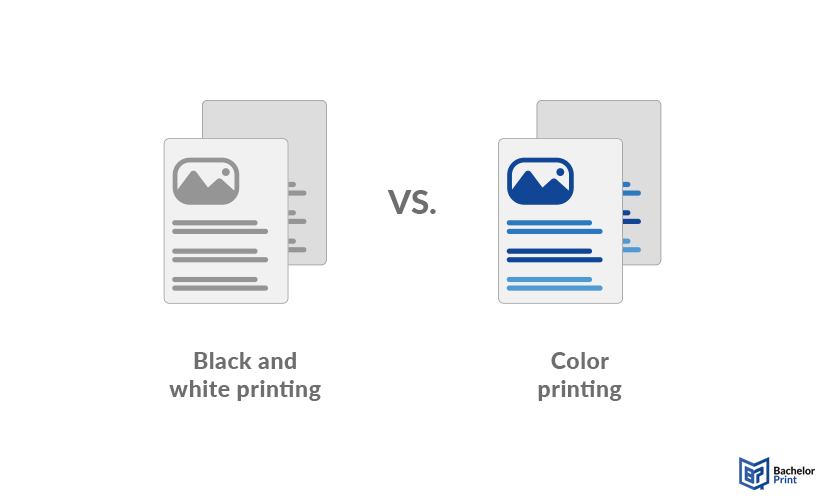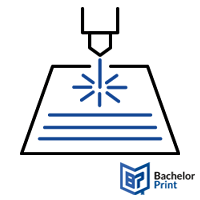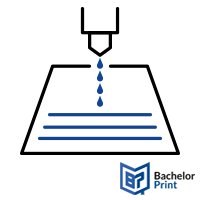
Whether it’s internal reports, instruction manuals, or academic papers, black and white printing remains a cornerstone of the print world. It’s cost-effective, fast, and highly versatile. In the realm of printing terms, “black and white” stands for much more than the absence of color: it’s a practical standard for everyday use.
Definition: Black and white
Black and white printing refers to a monochromatic process where only black ink or toner is used to reproduce text and images. Unlike full-color printing, it does not use cyan, magenta, or yellow. This method encompasses two primary styles:
- Monochrome (pure black and white)
- Grayscale
Monochrome printing uses only solid black and white, without any intermediate shades. It’s ideal for text documents and simple line art. The grayscale approach uses varying shades of gray to simulate depth or detail. It is particularly effective for reproducing photographs and complex graphics.
Due to its cost-effectiveness and efficiency, black and white printing is widely used in business and personal contexts. It’s especially suitable for materials where color is unnecessary, such as reports, manuals, and academic papers.
Print black & white copies online for £0.08
- Print black & white copies in bulk or in small quantities
- Affordable single- & double-sided black and white copies
- Professional printing service for individual solutions or printouts
Learn more!
Advantages & disadvantages
Black and white printing may seem simple, but it offers a range of practical benefits, especially for high-volume or text-heavy documents. At the same time, it has certain limitations that make color printing the better choice in some scenarios. Here’s a clear comparison of its pros and cons:
Advantages
- Ideal for formal documents like reports and contracts
- Utilizes only black ink/toner, reducing supply expenses
- Generally quicker than color printing, enhancing productivity
- Fewer cartridges and simpler mechanics lead to easier upkeep
- Consumes less energy and produces less waste compared to color printing
Disadvantages
- May be viewed as less premium compared to color prints
- Less effective in capturing attention for promotional content
- Not ideal for documents that rely on color coding or highlights
- Lacks the vibrancy needed for marketing materials or presentations
- Inadequate for printing images or graphics requiring color differentiation
When deciding, consider the nature of your documents and the impression you wish to convey. Black and white suits cost-effective, text-heavy prints; color is better for visually rich content.
Uses
Black and white printing is commonly used across many sectors due to its simplicity, speed, and low cost. Here are the most relevant areas of application:
Black and white printing is a standard in office environments where volume, clarity, and efficiency are key.
Educational institutions often use black and white printing for content-focused materials.
Black and white is often used in long-format printing to cut costs while keeping text clear.
Official documentation benefits from the clarity and archival stability of monochrome prints.
For everyday tasks at home, black and white is the go-to option due to affordability and practicality.
Black and white vs. color printing
Black and white and color printing each serve different purposes. This comparison highlights the key differences at a glance.
| Black and white | Color | |
| Cost | Low | High |
| Speed | Faster → Especially on laser printers |
Slower → Color processing and drying time |
| Ink usage | Only uses black toner/ink | Uses all CMYK cartridges |
| File setup | Simple → Less risk of formatting issues |
More complicated → Color management required |
| Appearance | Formal, clean, and efficient | Visually engaging and dynamic |
| Maintenance | Easier and less frequent | More complex with more components |
| Best used for |
|
|

Printing services at BachelorPrint
- Individual solutions & personal support
- High print quality & fast production times
- Wide range of print products for every need
Learn more!
Technology behind it
Black and white printing relies on either laser or inkjet technology, using only black toner or printing ink.

Laser printers use a laser beam to fuse toner onto the page using heat. This method is ideal for fast, high-volume printing with crisp text and consistent output, making it popular in offices and businesses.

Inkjet printers spray microscopic droplets of black ink directly onto the printer paper. They offer finer detail and smoother gradients, especially in grayscale images, and are typically used for lower-volume, high-precision tasks like photo printing.
Modern types of printers also use advanced grayscale algorithms to simulate depth and shading using only black ink.
FAQs
Black and white printing uses only black ink/toner to produce text and images, typically in pure black or grayscale, making it a cost-effective and widely used option for clear, content-focused documents.
Not exactly. Grayscale uses shades of gray to add depth, while pure black and white (monochrome) uses only solid black and white.
It uses just one ink or toner cartridge, reduces maintenance, and prints faster, lowering overall printing costs.
Yes, but it’s best to convert the file to grayscale first to avoid unexpected results in images or design elements.
Yes, it can be suitable for images, especially if they have strong contrast and clear structure. Grayscale allows for detailed photo reproduction, though subtle color variations and tones may not be fully preserved.